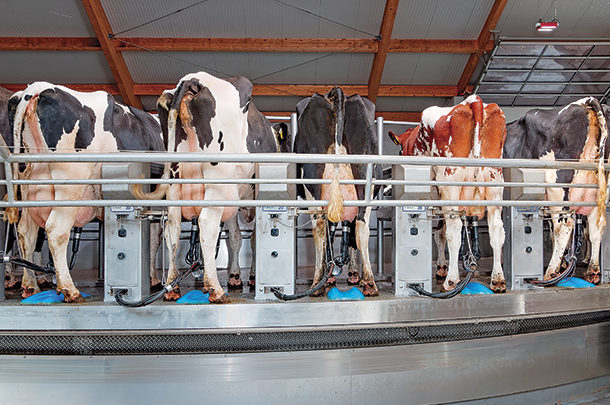Efficiency is defined as the ability to accomplish something with the least waste of time, effort and resources.
In the dairy business, we define and accomplish efficiency in many ways. How many cows can be milked per hour? How can we get more milk per hour? Is that through maximizing cows per hour or is it getting more milk per cow – or a combination of getting more milk per cow in a shorter time? How can we get more milk per man-hour of work?
How do you define efficiency for your system? Once you can define what will make your farm more profitable and more efficient, you can start investigating technology to help you reach your goals. But rather than focusing on just the amount of milk harvested in the parlor, let’s look at cow movement, labor use and the milking process as a whole – and from there, identify time, effort and resource-saving solutions that can help achieve your goals.
Efficiency of labor and cow movement
Most technologies available to assist in cow movement are not new to our industry. Some have been updated over time, and some may be considered “farm-grown.” One of the most exciting uses of technology for cow movement in the holding pen is a traffic light to indicate the current position of the crowd gate to the barn crew. Developed from a single red light into a red, yellow and green traffic light system by David Moser of Oak Ridge Dairy in Ellington, Connecticut, the light alerts the person pushing cows as to current holding pen capacity and when to push cows. According to Moser, “Green means it’s go time. The rotary loads so much smoother when the cows arrive right on time and are all facing the parlor. This timed operation doesn’t give cows time to mingle or turn around.”
When cows are in the holding pen, keeping that pen space at an appropriate size is also a challenge. Too little room creates stress and potential injuries, while too much room creates cow flow issues. Frequently, milkers must exit the pit area to push the “advance” button on the crowd gate or usher cows into the parlor. This is time away from actively milking cows. Automated crowd gate technology encourages cows to continuously move forward. It reduces the amount of time spent away from milking to move cows, and it reduces the need for milkers to enter the holding pen.
Now that we have the cows in the parlor and milked, we need to quickly get them out and back to eating and resting. Rapid exit has been around for many years and is a sure-fire efficiency booster. Advancements in design have addressed concerns about safety, cow comfort and, more recently, vertical and horizontal space saving. Some rapid-exit systems also allow for gang exit, or the release of smaller groups of animals to minimize cow flow bottlenecks at the parlor exit.
A producer can sort cows and automate the process in many different ways. You can use headlocks to go find and fetch cows within pens or manually divert cows as they exit the parlor based on an eartag number or marking. However, both of those activities require manpower and hours. One method to increase labor efficiencies is the use of cow identification, herd management data and sort systems. Sorts can be set up prior to a milking session for breeding purposes, pregnancy checks, vaccinations and other health events. Following milking, if the herd management system has detected a milk yield deviation, blood in the milk or displays other milking-type alarms, the system can automatically sort the cow based upon set thresholds. Milkers can also make a cowside sort selection using a touchscreen by the rotary. In both scenarios, the milkers can send a cow to the sort pen without fetching and examining.
Efficiency of the milking process
Finding efficiencies while harvesting milk is a delicate balance. Aggressive milking is known to impact udder and teat health. However, slow milking can also cause udder and teat health concerns. System vacuum should be set based on the average claw vacuums tested on numerous cows, and the ideal claw vacuum is set based upon the liner chosen. Today, we can even control vacuum per individual cow based on actual flow rate. Once a set flow rate has been reached, the vacuum level for that cow can be increased to speed the milk flow through the system and away from the cow. Low-flow, slower-milking cows would not experience the higher vacuum level.
One challenge with rotary parlors is a set speed of rotation for an entire herd. The faster-milking groups may get a free ride for half the rotation, while the high-production groups with longer milkout times may struggle to milk out completely. Almost every rotary needs the ability to automatically change speed based upon the groups’ average milking speed. For heavy-producing or longer-duration groups, the deck will slow down, and for lower-producing or short-milking-duration groups, the deck will speed up.
Efficiency of labor during milking
To help make the best use of labor on a dairy, consider the various technologies, from robotic teat spray applicators to fully robotic rotary milking systems. Automating a repetitive task reallocates man-hours to a higher-value role or eliminates them altogether. As robotics continue to develop and are able to handle more complex tasks, we will likely see robotic cluster attachment or attach-assist in parallels and rotaries become viable solutions as well.
With the increasing use of plant status monitoring and control systems in dairy operations, the ability to automate and monitor various tasks and functions becomes almost limitless. Simple tasks like milk filter or tank switching can now be done automatically, leaving employees to focus on the more strategic and management-related tasks. These plant status systems can also control everything from system cleaning to milk cooling system components that ensure everything is running smoothly and efficiently.
This type of system monitors the various components connected to it, enabling replacement of a failing component before it becomes a failed component in the middle of the night. Using various remote access platforms, dealer technicians and on-farm maintenance personnel can remotely monitor all functions and performance of the dairy operation.
Pulling the trigger on efficiency-driving technologies
Choosing the technology that’s right for you is a major financial decision that can’t be made without first identifying weaknesses and inefficiencies in your system. A third-party evaluation of your farm will provide insight from a different perspective, showing you things that have become normalized. If the addition of technology can improve those inefficiencies, also consider its return on investment.
Is return strictly a financial return, or is it better calculated in non-tangible outcomes, such as improved communication within crews, increased cow comfort or ease of completing a task? Oftentimes, a team effort among the on-farm staff, veterinarian, nutritionist and reproductive specialist will be the final key to determining which technologies will save the most time, effort and resources.
Pat Wiltzius is a solution manager for conventional milking systems with DeLaval. Email Pat Wiltzius.







